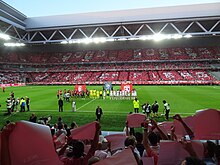football club
Lille Olympique Sporting Club ( french pronunciation : [ lil ɔlɛ̃pik spɔʁtɪŋ klœb ] ), normally called LOSC, LOSC Lille, or plainly Lille, is a french professional football club based in Lille, Hauts-de-France. They are the stream champions of Ligue 1, the top grade of french football. Lille has played its home matches since 2012 at Stade Pierre-Mauroy in nearby Villeneuve d’Ascq, which replaced the club ‘s former home of Stade Lille-Metropole.
Reading: Lille OSC
Lille was founded as a resultant role of a fusion between Olympique Lillois and SC Fives in 1944. Both clubs were founding members of the french Division 1 and Lillois was the league ‘s inaugural champions. Under the Lille emblem, the club has won four league titles ( in 1946, 1954, 2011 and 2021 ) and six Coupe de France titles. Lille ‘s most successful period was the ten from 1946 to 1956 when the team was led by managers George Berry and André Cheuva. [ 2 ] [ 3 ] Lille has a long-standing competition with nearby cabaret RC Lens, with whom they contest the Derby du Nord. The club is owned by Merlyn Partners SCSp, a Luxembourg based investing fund .
history [edit ]
1944–1955 : The beginning ten [edit ]
Before the second World War, the city of Lille had two clubs in Ligue 1 ; Olympique Lillois and Sporting Club Fivois. Weakened by the war, the two clubs decided to merge in the fall of 1944, giving give birth to Lille Olympique Sporting Club ( LOSC ). Within its first decade of universe, the new club won two league titles and reached the moment position for four back-to-back seasons. In the Coupe de France the golf club accumulated five wins in seven finals, including five consecutive finals. The final examination of the Latin Cup was besides reached .
1956–1980 : Lille loses its direction [edit ]
Lille were relegated for the first gear time in 1956. The baseball club became a mid-table english and in the late 1960s, after a long period of anonymity, and weighed down by a lack of facilities and resources, Lille abandoned its professional status. It was feared that the club might disappear. however, some young leaders, such as Max Pommerolle, came and gave newly drift to the club. Nevertheless, the results remained erratic and the only titles that ignited the fans ‘ passions were won in the Second Division .
1980–2000 : Laying the foundations for future success [edit ]
In July 1980, Lille was the first french baseball club to opt for the status of a desegregate economy company, of which the city of Lille became the majority stockholder. The team of presidents Amyot, Deschot and Dewailly all struggled to compete with the top teams in the country. Jacques Amyot ‘s resignation in 1990 led to three more difficult years for the club which compromised its very universe. It took Bernard Lecomte ‘s arrival in 1993 to set the club finances on the road to recovery. After a final relegation in 1997, the team trained by bosnian coach Vahid Halilhodžić was soon promoted back to the elite, in the same year the french Football League was privatised .
2000–present : A brace climb to the crown [edit ]
In just its first season back in the top trajectory 2000–01 french Division 1, Lille qualified for Europe for the first time in the club ‘s history, booking its place in the 2001–02 Champions League. On the back of the cabaret ‘s raw status, Lille entered into a critical new era under the guidance of president and chief executive officer Michel Seydoux and coach Claude Puel. The cabaret left the diachronic Stade Grimonprez-Jooris to join the Stadium Lille Métropole and became a regular on the european setting. Amongst its most emphatic results was the 1–0 victory over Manchester United at the Stade de France in 2005, the 2–0 gloat over Milan in San Siro in 2006 and the 1–0 home win over Liverpool in 2010. A steady development off the pitch ( inauguration of the Domaine de Luchin training building complex in 2007, opening of the Grand Stade in 2012 ), coupled with the sporting progress under the technical pass of coach Rudi Garcia, took Lille back to the summit of the french game with the League and Cup bivalent in 2011 ( 56 years after the cabaret ‘s last trophy ). In 2012, LOSC confirmed its place at the top table of the domestic game with another qualification for Europe ‘s most prestigious club competition, the Champions League in 2012–13. With the club eat up equitable outside the UCL places that temper, Garcia left to join Roma, while early Montpellier coach René Girard was appointed the new Lille director. [ 4 ] After two years in charge of the club, Girard left his role as the drumhead coach by reciprocal accept. He was joined by assistants Gerard Bernadet and Nicolas Girard in making the exit. In May 2015, the Ivory Coast national team head coach Hervé Renard was appointed as the new director. On 11 November 2015, Renard was terminated as director and was replaced by Frederic Antonetti. [ 5 ] [ 6 ] On 23 November 2016, a class after being appointed, Lille terminated Antonetti ‘s contract with the club lying second last in the table. [ 7 ] In March 2017, Lille appointed Marcelo Bielsa as new coach of the club. In November 2017, Bielsa was suspended by Lille following an unauthorized stumble to Chile with the club lying second from penetrate on the mesa again and entirely managing 3 wins from the first 14 games of the season. [ 8 ] On 23 December 2017, Bielsa was terminated by Lille and replaced with former Saint-Etienne coach Christophe Galtier. [ 9 ] After a unmanageable 2017–2018 temper, Lille managed to avoid relegation to Ligue 2 by defeating Toulouse 3–2 in the second last game of the campaign. [ 10 ] In the 2018–19 Ligue 1 season, Lille secured the second topographic point to qualify for the 2019–20 UEFA Champions League group stagecoach, they returned to the contest after a seven-year absence. [ 11 ] Two seasons late, in the 2020–21 season, Lille won their first Ligue 1 style in 10 years and the one-fourth overall in club history under the guidance of Christophe Galtier. [ 12 ]
Stadiums [edit ]

Club rivalries [edit ]
The Derby du Nord is a football meet contested between Lille and RC Lens. The bowler hat name refers only to their geographic location in France since Lille is the only cabaret of the two actually situated in the department of Nord. Lens are situated in the western department of Pas-de-Calais. The name can besides refer to matches involving Lille and Valenciennes as both clubs are located within Nord, however, the match historically refers to matches involving Lille and Lens. As a consequence, the Lille–Valenciennes catch is sometimes referred to as Le Petit Derby du Nord. The two clubs first met in 1937 when Lille were playing under the Olympique Lillois emblem. ascribable to each club ‘s cheeseparing proximity towards each other being separated by only 40 kilometres ( 25 nautical mile ) and sociological differences between each club ‘s supporters, a boisterous competition developed. The Derby du Nord is underpinned by social and economic differences, since the city of Lens is known as an previous, propertyless, industrial city and Lille as a middle-class, modern, internationally oriented one. Nowadays the matches, which can spark intense feelings on both sides, have gained bulge as they may determine berths in continental competitions .
Players [edit ]
current team [edit ]
- As of 1 December 2021[14]
bill : Flags indicate national team as defined under FIFA eligibility rules. Players may hold more than one non-FIFA nationality.
Read more: S.L. Benfica
early players under contract [edit ]
note : Flags indicate national team as defined under FIFA eligibility rules. Players may hold more than one non-FIFA nationality .
Out on lend [edit ]
note : Flags indicate national team as defined under FIFA eligibility rules. Players may hold more than one non-FIFA nationality .
Reserve team [edit ]
note : Flags indicate national team as defined under FIFA eligibility rules. Players may hold more than one non-FIFA nationality .
noteworthy past players [edit ]
Records [edit ]
Most appearances [edit ]
top scorers [edit ]
management and staff [edit ]
Lille Olympique Sporting Club – LOSC Lille ( SASP ) [ 15 ]
Coaching history [edit ]
former coaches include Georges Heylens ( 1984–89 ), a former belgian international player, Jacques Santini ( 1989–92 ), who coached the France national team between 2002 and 2004, Bruno Metsu ( 1992–93 ), who coached the Senegal national team at the 2002 World Cup, Pierre Mankowski ( 1993–94 ), who was once the assistant coach of the France home team and Vahid Halilhodžić ( 1998–02 ), who can be credited with the club ‘s revival in the late nineties. Rudi Garcia, who played for Lille from 1980 to 1988, replaced Claude Puel at the begin of the 2008 season. Puel had been with Lille since 2002. Thanks to his successes with the club, Puel had been approached by portuguese baseball club Porto to replace José Mourinho and league rivals Lyon to replace Alain Perrin ; he ultimately decided to join Lyon after six seasons at the club .
Honours [edit ]
domestic [edit ]
Europe [edit ]
References [edit ]
Read more: Real Sociedad
